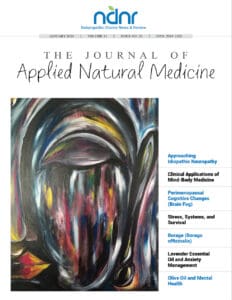Carina Parikh
Steven Sandberg-Lewis, ND, DHANP
Crohn’s disease (CD) is 1 of 2 disorders classified under Inflammatory Bowel Disease (IBD). Prevalence and incidence of IBD is steadily increasing in all areas of the world, and some claim that it has become a global disease.1 Rates of IBD are rising in South Korea, India, Lebanon, Iran, Africa, Thailand, and the French West Indies, in parallel with the westernization of these areas.2
Crohn’s & the Role of Diet
CD can affect any part of the gastrointestinal system, but the most common affected area is the ileum. The immune system mistakenly recognizes commensal gut bacteria that aid in mucosal functions as invaders, and signals for an immune response that leads to chronic inflammation of the intestines. CD is an inflammatory condition, and the majority of symptoms stem from the patient’s continuously inflamed digestive tract. Over time, the overactive immune response and inflammation leads to a variety of gastrointestinal symptoms, such as abdominal pain, distention, bloating, fatigue, diarrhea or constipation, blood in the stool, weight loss, and perianal disease. Other complications include fistulas, strictures, abscesses, perforation, and malnutrition. Research to help understand how to manage CD is of critical importance.
Diet may play a role in CD pathology. Fructose and lactose often remain unabsorbed in the lumen of the small intestine, hence reaching the colon and becoming fermented by bacteria. This produces a number of abdominal symptoms, such as bloating, cramping, pain, and distention.3 Carbohydrate malabsorption is a common feature of patients with gastrointestinal difficulties.3 Previous studies have shown that reducing consumption of fructose and lactose by omitting fermentable carbohydrates from the diet can reduce abdominal symptoms.3 Other studies have linked abdominal symptoms and pain to dairy and grains, especially wheat and rye, as well as to excess fiber intake.4 One study looked at pre-illness diets of people diagnosed with Crohn’s and found that compared to controls, people who were diagnosed with Crohn’s ate significantly more refined sugar and less dietary fiber and raw produce.5 Another retrospective study, examining how dietary habits play a role as risk factors for Crohn’s, found that participants who were diagnosed with CD had a significantly higher intake of refined carbohydrate and starch.6 Because of the potential role of dietary habits in the development, progression, and maintenance of CD symptoms and pathology, there may be benefit in treating CD patients with a dietary intervention.
Case Report
Initial Presentation & Lab Testing
A 40-year-old female with a primary diagnosis of Crohn’s ileocolitis presented to the clinic in May of 2014. She was diagnosed by colonoscopy and biopsy in October of 2013. Her gastrointestinal symptoms developed shortly after she began treatment for a case of recurrent MRSA (involving several antibiotics over a period of 10 years), and worsened over time throughout the treatment. She developed chronic diarrhea and anal itching, which were accompanied by insomnia, fatigue, eczema, rosacea, frequent colds, and recurrent vaginal yeast and staph infections. Her symptoms were having a profound effect on her quality of life, as she was forced to maintain a limited work schedule and sleep the majority of her weekends. The patient followed an elimination diet, which moderately improved her brain fog and energy level. She sought alternative care because her gastroenterologist’s next treatment option was infusions of a commonly prescribed TNFα inhibitor; TNFα is a proinflammatory cytokine that is elevated in patients with CD. She was concerned about this option in light of her ongoing MRSA issue and the drug’s known risk for increasing infection; her goal was to put her Crohn’s into remission to avoid having to take it. The patient was prescribed 12 mg of budesonide (a synthetic corticosteroid) at the time of her diagnosis of CD, and when she presented to the clinic, she was being maintained on a dose of 3 mg per day.
ELISA serum testing revealed elevated IgG antibodies to gluten, soy, dairy, kidney beans, pineapple, and almonds. She began avoiding these foods and claimed that this made her feel better, though she was not 100% adherent to the diet. During her initial visit to the clinic, she was put on the GAPS7 introduction diet for 1 month, and was then instructed to follow the Small Intestinal Bacterial Overgrowth (SIBO) Foodguide, in an attempt to manage her symptoms and put her CD into remission.
Dietary Intervention
GAPS Introduction Diet: The Gut and Psychology Syndrome Diet (GAPS)7 is a diet designed to reset the digestive system and heal the intestinal tract. The introduction diet is the first stage of this diet and is designed to last 4-6 weeks. Once the introductory stage has been successfully completed, foods can be gradually reintroduced. The base of the introduction diet is homemade stocks and soups, especially chicken. Homemade yogurt, kefir, and sauerkraut are added in to replenish beneficial bacteria that has been lost. Other foods (added in stages) include egg yolks, avocado, nut butters, ghee, certain non-fibrous vegetables, and meats.
SIBO Foodguide (SCD + FODMAP diets): The SIBO diet8 focuses on eliminating certain fermentable carbohydrates that provide a substrate for bacterial production of hydrogen and methane gas in the intestines. Removing this substrate helps reduce abdominal symptoms in the host by decreasing gas production. The SIBO Foodguide8 is a combination of the Specific Carbohydrate Diet (SCD)9 and the low FODMAP diet.10
Results
Follow-Up Visits
After 1 month on the prescribed dietary regimen, the patient returned to the clinic for a follow-up visit. She reported that within 1 week her gastrointestinal symptoms had significantly subsided. She still struggled with fissures, though she stated that they were no longer as painful. Her gastroenterologist told her that her CD was in remission. She reported that she no longer needed an excess amount of sleep and that she had a lot more energy. She expressed excitement about her progress. She began introducing some foods on the “moderate FODMAPs” list of the SIBO Foodguide, eg, strawberries, salad, sauerkraut, bell peppers, and collard greens, with no apparent negative symptoms. Her sentinel tags had decreased in size, and she reported having 0-2 bowel movements per day [with a Bristol 4 consistency], and only occasional diarrhea. She was told to continue the diet and gradually add in more “moderate” foods as she was able, 1 at a time.
One month after the initial follow-up visit, she returned for a second visit to assess progress. At this point, she continued to lose desired weight and had enough energy to start adding more activity into her daily routine. She purchased a pedometer, with the aim of taking 10 000 steps per day; she has been successful with this and has had the energy to do so. She was able to add in some higher FODMAP foods, including broccoli, celery, cabbage, mushroom, onion, and leeks, all without digestive discomfort. She remains on the budesonide, per her gastroenterologist’s recommendation. At this visit, going off the budesonide was discussed. We decided that if she were to do so, she would need to go back to only the “allowed” foods on the SIBO diet (meaning SCD-legal and low FODMAP) until she was successfully off of the medication. She reported at this visit that she feels significantly better.
Follow-Up Lab Results
During the first follow-up visit, calprotectin (a quantitative stool marker of inflammation) measured 183 µg/g (normal <50 µg/g), which was a large reduction from her baseline measurement of 635 µg/g. Her SIBO breath test indicated a borderline-positive hydrogen count of 21 ppm and 0 for methane gas.
At the second follow-up visit, the patient’s calprotectin level had dropped to 78 µg/g (much closer to the normal range), with no change in the SIBO breath test results.
Discussion
The Specific Carbohydrate Diet9 removes starchy carbohydrates (disaccharides and polysaccharides) that feed the bacteria implicated in Crohn’s Disease, with the goal of decreasing overgrowth of microorganisms in the gut and healing the damaged intestines. In one study, the SCD successfully reduced abdominal symptoms in children with CD who followed the diet for an average of 14 months.11 FODMAPs, which stand for fermentable, oligo-, di-, mono-saccharides and polyols, are short-chain carbohydrates found in modern carbohydrates that are not easily absorbed by the small intestine, and thus cause digestive distress in a large proportion of people consuming a mainly Western diet.10 Characteristics of FODMAP intolerance include luminal distention, bloating, abdominal distention, pain, and flatulence. When a FODMAP-intolerant person consumes these foods, they pass undigested and unabsorbed through the small intestine into the large intestine, where bacteria ferment them, causing digestive distress. The SIBO diet,8 as compiled by Dr Allison Siebecker, combines the SCD and a low-FODMAP diet. It is designed to reduce the amount of bacteria in the intestines, thereby eliminating digestive symptoms. The SIBO Foodguide divides foods into 3 categories, marked as red, yellow, and green lists.
Previous research examining the effect of diet on gastrointestinal diseases suggests that eliminating sugars and starchy carbohydrates may reduce or eliminate symptoms related to IBD.3 One study found that consuming high-FODMAP foods resulted in an increased production of hydrogen gas in the colon, as well as gastrointestinal distress, in participants with gastrointestinal diseases compared to controls.9 This research is backed up by the results from the current case report: after 1 month on the diet the patient exhibited significant relief from her gastrointestinal symptoms, and by 2 months on the diet her fecal calprotectin levels had decreased from 635 µg/g (moderately high range) to 78 µg/g (very mild range), indicating a marked reduction in intestinal inflammation.12 A variety of her other symptoms subsided as well, such as the fatigue, allergies, fissure severity, and abdominal discomfort. Though her SIBO test remained positive for hydrogen gas, this lab result was only borderline clinical. Given the history of recurrent antibiotic use and her frequent medical problems, she was at risk for developing CD. Antibiotics are known to influence the gut flora in the digestive tract,13 so it is possible that her frequent rounds of antibiotics destroyed many of her beneficial gut bacteria that normally prevent overgrowth of microorganisms, thereby leading to gastrointestinal symptoms and, eventually, the development of CD. The dietary intervention helped to reverse this overgrowth.
In conclusion, this case report indicates the success of a dietary intervention in treating a patient with moderate Crohn’s disease. Dietary treatment of CD should be further investigated as a potential way to treat and manage the illness without necessarily subjecting patients to treatments that have the potential to cause more long-term problems and side effects, such as those from drugs or surgery.
 Carina Parikh is currently a student at the National College of Natural Medicine (NCNM), where she is pursuing 2 degrees – a Masters of Science in Integrative Medicine Research, and a Masters of Science in Nutrition. She has a strong interest in healing and managing chronic disease through diet, and hopes to begin a practice in nutritional counseling when she is finished with her programs.
Carina Parikh is currently a student at the National College of Natural Medicine (NCNM), where she is pursuing 2 degrees – a Masters of Science in Integrative Medicine Research, and a Masters of Science in Nutrition. She has a strong interest in healing and managing chronic disease through diet, and hopes to begin a practice in nutritional counseling when she is finished with her programs.
 Steven Sandberg-Lewis, ND, DHANP, has been a practicing naturopathic physician since his graduation from National University of Natural Medicine (NUNM) in 1978. He has been a professor at NUNM since 1985, teaching a variety of courses but primarily focusing on gastroenterology and GI physical medicine. His clinic rotations are particularly popular among NUNM doctoral students. In addition to supervising clinical rotations he also maintains a part-time practice at 8Hearts Health and Wellness in Portland, Oregon.
Steven Sandberg-Lewis, ND, DHANP, has been a practicing naturopathic physician since his graduation from National University of Natural Medicine (NUNM) in 1978. He has been a professor at NUNM since 1985, teaching a variety of courses but primarily focusing on gastroenterology and GI physical medicine. His clinic rotations are particularly popular among NUNM doctoral students. In addition to supervising clinical rotations he also maintains a part-time practice at 8Hearts Health and Wellness in Portland, Oregon.
He is a popular international lecturer at functional medicine seminars, presents webinars, writes articles for NDNR and the Townsend Letter and is frequently interviewed on issues of digestive health and disease. He is the author of the medical textbook Functional Gastroenterology: Assessing and Addressing the Causes of Functional Digestive Disorders, Second Edition, 2017, which is available at amazon.com. In 2010 he co-founded the SIBO Center at NUNM which is one of only four centers in the USA for Small Intestine Bacterial Overgrowth diagnosis, treatment, education and research. In 2014 he was named one of the “Top Docs” in Portland monthly magazine’s yearly healthcare issue and in 2015 was inducted into the OANP/NUNM Hall of Fame.
Within gastroenterology, he has special interest and expertise in inflammatory bowel disease (including microscopic colitis), irritable bowel syndrome (including post-infectious IBS), Small Intestine Bacterial Overgrowth (SIBO), hiatal hernia, gastroesophageal and bile reflux (GERD), biliary dyskinesia, and chronic states of nausea and vomiting.
Many of the patients referred to Dr. Sandberg-Lewis have digestive conditions that have defied diagnosis and effective resolution. Often these patients desire naturopathic treatment options in lieu of the courses of treatments they have previously undergone. He understands diseases of the gastrointestinal tract, but also can assess function and often find successful treatments to regain a balance in the digestive system.
Dr. Sandberg-Lewis lives in Portland with his wife, Kayle. His interests include mandolin, guitar and voice; cross country skiing; writing and lecturing.
References
Molodecky NA, Soon IS, Rabi DM, et al. Increasing incidence and prevalence of the inflammatory bowel diseases with time, based on systematic review. Gastroenterology. 2012;142(1):46-54.
Ponder A, Long MD. A clinical review of recent findings in the epidemiology of inflammatory bowel disease. Clin Epidemiol. 2013;5:237-247.
Goebel-Stengel M, Stengel A, Schmidtmann M, et al. Unclear abdominal discomfort: pivotal role of carbohydrate malabsorption. J Neurogastroenterol Motil. 2014;20(2):228-235.
Gwee KA. Fiber, FODMAPs, flora, flatulence, and the functional bowel disorders. J Gastroenterol Hepatol. 2010;25(8):1335-1341.
Thornton JR, Emmett PM, Heaton KW. Diet and Crohn’s Disease: characteristics of the pre-illness diet. Br Med J. 1979;2(6193):762-764.
Tragnone A, Valpiani D, Miglio F, et al. Dietary habits as risk factors for inflammatory bowel disease. Eur J Gastroenterol Hepatol. 1995;7(1):47-51.
Campbell-McBride N. Gut and Psychology Syndrome. Cambridge, England: Medinform Publishing; 2010. Summary available at: www.gapsdiet.com. Accessed September 12, 2014.
Siebecker A. SIBO Foodguide. Available at: http://www.siboinfo.com/uploads/5/4/8/4/5484269/sibo_specific_diet_food_guide_sept_2014.pdf. Accessed September 12, 2014.
Gottschall E. Breaking the Vicious Cycle. Baltimore, ON: Kirkton Press; 1994. Summary available at: http://www.breakingtheviciouscycle.info/p/about-the-diet/. Accessed September 12, 2014.
Ong DK, Mitchell SB, Barrett JS, et al. Manipulation of dietary short chain carbohydrates alters the pattern of gas production and genesis of symptoms in irritable bowel syndrome. J Gastroenterol Hepatol. 2010;25(8):1366-1373.
Suskind DL, Wahbeh G, Gregory N, et al. Nutritional therapy in pediatric Crohn disease: the specific carbohydrate diet. J Pediatr Gastroenterol Nutr. 2014;58(1):87-91.
Vieira A, Fang CB, Rolim EG, et al. Inflammatory bowel disease activity assessed by fecal calprotectin and lactoferrin: correlation with laboratory parameters, clinical, endoscopic and histological indexes. BMC Res Notes. 2009;2:221.
Dethlefsen L, Huse S, Sogin ML, Relman DA. The pervasive effects of an antibiotic on the human gut microbiota, as revealed by deep 16S rRNA sequencing. PLoS Biol. 2008;6(11):e280.

